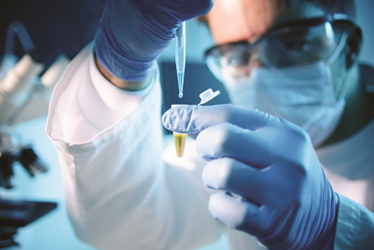QuantStudio Absolute Q Viral Titer Digital PCR Assays

Applied Biosystems Absolute Q Viral Titer dPCR assays enable easy and accurate quantification of viral vectors. The assays can be run individually or multiplexed using a custom assay with your target gene of interest to measure concentration and evaluate quality for biopharma and gene therapy research.
Absolute Q dPCR assays are:
- Simple—streamlined workflow for ease-of-use with your digital PCR instrument
- Fast—minimal hands-on time; results in 90 minutes when used with the QuantStudio Absolute Q Digital PCR System
- Dependable—analyze your data with confidence using verified assays backed by a performance guarantee*
Viral vector and plasmid development for cell and gene therapy
As demand for cell and gene therapy continues to increase, so too does the demand for viral vectors and plasmid DNA development. Gene and cell therapies utilize a variety of viral vectors for gene transfer, including adeno-associated viruses (AAV), lentiviruses, retroviruses, herpes viruses, adenoviruses, and others. Among them, AAV-mediated gene therapy is garnering the most interest due to its safety profile since infection with the vector is not pathogenic, and AAV cannot replicate on its own. The AAV viral vectors, as well as the messenger RNAs produced from plasmid DNA template, are the critical intermediates that produce and carry the chimeric antigen receptor (CAR) to T-cells enabling CAR-T therapies.
Accurately measuring viral titer in gene therapies
Controlling the concentration of a potential therapeutic is difficult since viral particles are produced in living cells and then purified. The process of generating and purifying viral vectors is also susceptible to contamination by host cell DNA, mycoplasma, and other contaminants. Viral titer must be measured accurately, precisely, and consistently to ensure correct formulation. Harmful adventitious agents (virus, bacteria, and fungi) and contaminant DNA must be detected and screened out with the highest sensitivity to ensure product quality and safety.
While real-time PCR remains the gold-standard tool for the quantitation of therapeutic viral vectors such as AAV used in cell and gene therapies, digital PCR (dPCR) offers significant advantages for quantification of target DNA molecules in a range of analytical assays necessary for viral vector production and characterization.
Unlike real-time PCR, dPCR can provide an absolute count of nucleic acids, enabling the precise quantification of AAV vectors, bacterial contaminants, and residual host cell DNA. No reference standard is required, improving precision and removing a source of variation. The variability in the standard curve used for real-time PCR is often due, in part, to the different architectures of the relevant DNA species: circular, supercoiled, linear DNA, or viral particles. dPCR is also less sensitive to contaminants that affect amplification, including those present in solutions used during the development of AAV-mediated gene therapies.
